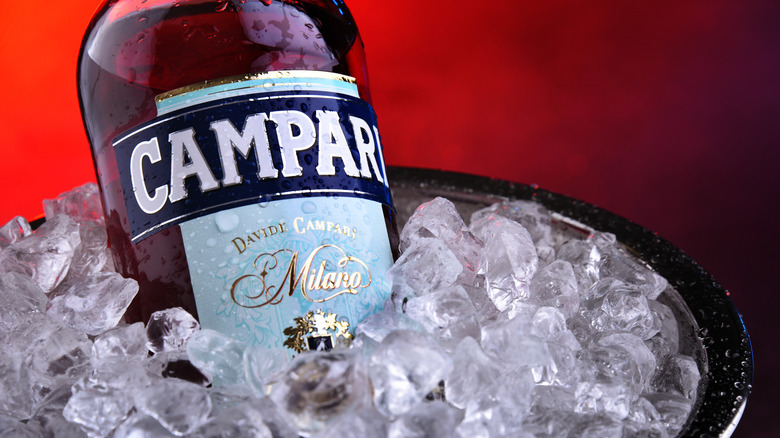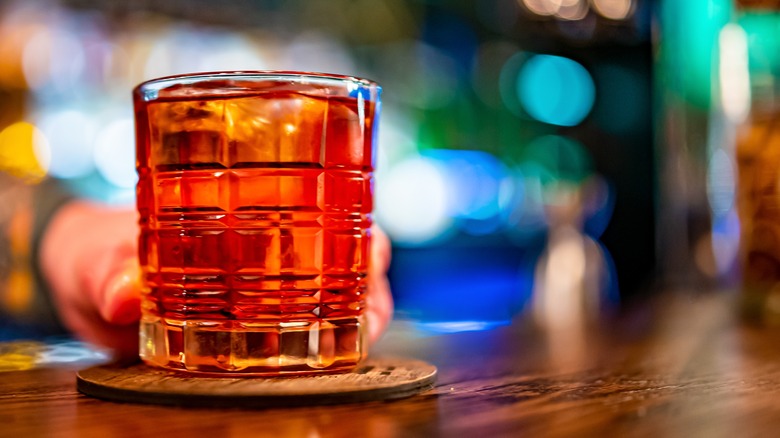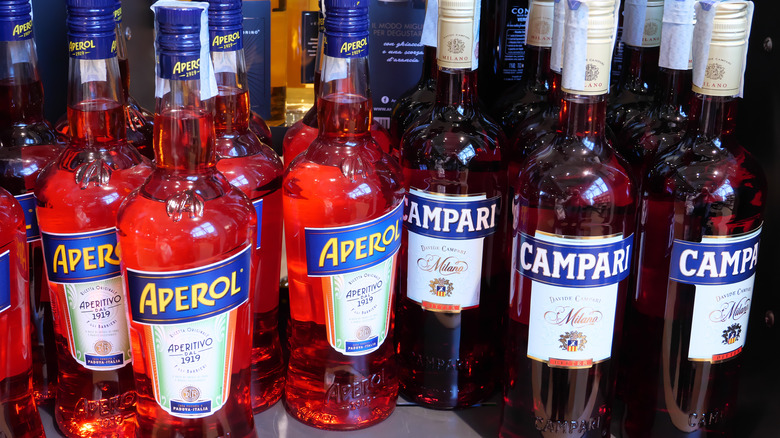Campari: The Ultimate Bottle Guide
The world of aperitifs is most definitely worth delving into, and there is no liqueur better suited for whetting the appetite and kicking off the evening than Campari. Aperitifs have a unique purpose in the drinks space of providing a boozy addition to a brunch or start to a night while also aiding digestive and gut health. Campari is the king of aperitifs, so you're better off knowing the best way to enjoy it and what exactly it even is.
You may not have noticed this intensely red, Italian bitter on bar shelves before, but that just means you weren't looking for it. The next time you're in a bar, whether it's a dive or a luxury lounge, keep an eye out for this bottle and chances are you will find it. This iconic herbal liqueur is ripe with history and can be found in a wide array of classic drinks and the infinite riffs they inspire. The taste for Campari is an acquired one, but once you give it a fair shot, the doors will be opened to a whole new corner in the world of cocktails. Here's everything you need to know before you go exploring.
History of Campari
The origins of Campari date back over a century. Gaspare Campari, born in 1828, began tending bar as a teenager in his hometown of Cassolnovo in the Lombardia region, according to The Manual. By 1840, Campari began developing his own aperitifs and liqueurs, experimenting with different ingredients and even selling what he was proud of. It was not until 1860, however, that Gaspare caught lightning in a bottle in the city of Novarra and the bitter red aperitivo we know and love today was born. The recipe has remained unchanged since.
In 1887, Campari relocated his business to Milan. There, he opened Caffe Campari, the legendary bar where the famous Americano cocktail was invented. As Campari's lifespan evolved into the 20th century, a mass production laboratory was established in Milan. By the end of the 1920s, Campari ended up growing its business to eventually reach over 200 countries.
Since then, Campari has not only been a powerhouse in the spirits world, it has been an advocate and proponent of art, creativity, and charity. Campari and Imbibe Magazine partner up to benefit a charity through "Negroni Week." Participating bars and restaurants donate a portion of their Negroni sales to the new cause each year and are encouraged to mix up their own spins on the classic cocktail. The annual event that began in 2013 now includes thousands of participants around the globe and raises an estimated $3 million every year.
How is Campari made?
Although Gaspare Campari's original 1860 recipe remains unaltered, its exact components have always been kept a closely guarded secret. What is certain is Campari is made from a blend of alcohol, sugar, distilled water, and an infusion of orange, rhubarb, ginseng, and a combination of herbs, the types and amounts of which are known only by the factory director (via Saveur). In fact, some of the herbs are sent right to the factory director in labelless packaging.
The dry ingredients soak in water for 48 hours, are mixed with more water and alcohol, and then steep in vats for over two weeks. After that, the liquid — brown at this stage — is drained off and made ready for the addition of sugar and the coloring agent. The alcohol content of the finished product actually varies depending on the market it's going to. In the American market, it's 24% alcohol. Campari bottles meant for U.S. consumption are called "Aperitivo," since the "Bitter" label used in other markets would likely sound off-putting to American drinkers.
The only change that has been made to Campari since 1860 is what gives it its red color. According to The New York Times, the color was originally achieved using a natural dye called carmine, which is extracted from tiny insects called cochineals. This was the practice until 2006 when it was discontinued because of an "uncertainty of supply." Since then, artificial colorings have been used to give Campari its iconic color.
What does Campari taste like?
The bitterness found in Campari is not uncommon in aperitifs, but it is definitely bold. Before the bitter herbaceousness hits your palate, the main flavor you can find in Campari either by sipping it straight or diluted with Campari soda is definitely orange. This is why you will often notice Campari cocktails are garnished with an orange slice or peel. Just like how gin and tonics are best garnished with a botanical used to make the gin, orange garnishes are used to highlight those flavor notes in the Campari.
It should be understood that anyone's first sip of Campari or a Campari cocktail will almost certainly place emphasis on the bitterness. However, the sweetness of the orange and the warmer herbs will begin to show themselves the more you give Campari a try. As stated earlier, Campari is an acquired taste. Although the bitterness is always present, discovering the more nuanced flavor notes and aromas of Campari is what has made it such a cocktail staple.
How to drink Campari
The bitterness of Campari is part of what makes it great. Aperitifs like Campari are meant to be drunk prior to eating. This is because the bitterness of aperitifs springs digestion into action as your body does its best to expel the bitterness as quickly as possible. Once it's time to eat, the food that enters your stomach will immediately begin to be broken down by the flowing acids that have already gotten to work.
Campari can definitely be sipped on its own, but newcomers to the aperitivo should probably go for a mixed cocktail that does well to balance out its bitterness and highlight its sweeter flavor notes. Fortunately, there is a bevy of excellent Campari cocktails to choose from. An Americano or Negroni accomplish this bittersweet balance beautifully, and once you've tried them, you can do a deep dive into the endless Negroni variations out there. For a milder introduction that is maybe more straightforward, swapping Aperol out for Campari in a spritz makes for a vibrant, fresh take on what you've probably had many times before. Campari also plays beautifully in a bicicletta, a cocktail with white wine and soda water.
As always, how you enjoy anything is entirely up to your own preference. The important thing is giving Campari a fair shot and finding its best form for you. Again, it may not be love at first sip, but with an open mind and palate, Campari will become a mainstay on your bar cart.
Is Campari expensive?
Campari definitely deserves a place in your home bar, and you don't have to worry that buying a bottle will break the bank. According to Wine Searcher, the average price of a regular-sized bottle of Campari is $33. Given the countless drinks you can mix using Campari, this price point is very much worth it.
Plus, Campari's shelf life is longer than other liqueurs. As long as the bottle is kept either at room temperature or in the refrigerator, it should keep its flavor and aroma for about one year, per Eat Delights. This works out well because most cocktails that include Campari only call for a small amount — usually just an ounce or less — so you shouldn't have to worry about finishing the bottle before it turns.
If you don't have a bottle of Campari at the moment, it's probably best you get one sooner rather than later. Over the past year, Campari Group has been struggling to bounce back from the global pandemic, per Bloomberg. Because bars weren't ordering Campari or Aperol (another aperitivo by the Campari brand) as well as supply chain issues, the cost of a bottle of Campari has risen. Now that these setbacks seem to have settled, these prices will most likely not go back down, and hopefully not continue rising. Regardless, getting your hands on a bottle or ordering a Negroni or two the next time you go out is well worth the extra dollars.
Campari vs Aperol
Acquired by Campari Group in 2003, Aperol is an orange aperitivo that also calls northern Italy its home. It was founded in 1919 and has become arguably the most popular aperitif out there, next to Campari. With an ABV of just 11%, Aperol does not pack the punch Campari does, but that lower alcohol does help make it a more approachable aperitivo as well as a great choice for a more pace-setting start to an evening.
While Campari is indisputably bitter, Aperol is best described as bittersweet. Aperol is also made with herbs, but it's the orange and sugar that are really bumped up in comparison to Campari. Notes of vanilla help to round out any herbal bitterness and allow the orange to really take center stage. If you'd prefer to sip on an aperitif neat or just on the rocks, Aperol is probably the better choice for beginners. Otherwise, there is also a wide range of Aperol cocktails worth trying as well. The Aperol Spritz is the obvious icon, but the modern classic Paper Plane calls for Aperol, and the aperitivo can play substitute in a Negroni for those who want a more subdued introduction to the cocktail.
Despite the difference between Aperol and Campari, it really doesn't make sense to pit the two aperitivos against one another. Not only do they belong to the same company, but both are delicious, affordable bottles with differences that complement each other. Give Aperol a try if you like Campari, and vice versa.
Campari has health benefits
Health setbacks are common concerns when enjoying a drink or two. Alcohol usually does not fit well into restrictive diets, whether they are meant for weight loss or just to maintain overall health. Campari, on the other hand, doesn't have sacrifice. We know that Campari and aperitifs in general aid in digestion and gut health, but here's how those benefits actually come to fruition.
According to Dr. Health Benefits, Campari supports the body's enzyme production in the digestive system. These enzymes break down starches into smaller, more manageable molecules. This improves energy, protects the body from diabetes and cancer, and also works as a stress regulator. And contrary to the most common health concern of alcohol, Campari is beneficial for your liver as well.
Because of Campari's bitterness, the liver produces extra amounts of bile which are later used in digestion, breaking down fats into fatty acids to make them more easily digested and absorbed. The more bile available, the more easily food and drink are broken down. As Orson Welles once said about the Negroni, "The bitters are excellent for your liver, the gin is bad for you. They balance each other out" (via The New York Times). Not exactly expert health advice, but we think Welles might've been onto something here.
Campari has its own art gallery
Since its spike in popularity in the early 20th century, Campari has been an impassioned advocate and innovator for art. According to the brand, Campari's "futuristic advertising" in the 1930s used geometric shapes and dynamic designs to represent the brand as a new, progressive product that couldn't be missed, almost as the "next big thing," so to speak.
In 2010, to celebrate the brand's 150-year anniversary, Campari opened its very own art gallery in Milan as a testament to its timeless artistic flair and influence. The gallery, called Galleria Campari is located in Campari Group's headquarters in Sesto San Giovanni in Milan. Designed by Mario Botta, the gallery features interactive displays, original posters, and books dating as far back as 1900. At Galleria Campari, you can also view Campari's television commercials and short films that aired in the 1960s and 1970s on Italian broadcasts.
Galleria Campari also includes a timeline of its bottle design ranging from inception to current, as well as a multitude of Campari-licensed bar tools and glassware that date back multiple decades. Walking through Galleria Campari truly communicates a perfect fusion of tradition and history and looking ahead to the future.
Campari was used to celebrate Italian unification
Italian history dates back thousands of years, going all the way back to ancient Rome, but the Italy we know today is actually a very recently established nation. Only unified in 1861, Italy was previously made up of separate regions called city-states, each with its own governments, leaders, and population. Giuseppe Garibaldi led the way toward and accomplished unification, and the cocktail named after him serves as a symbol of the newly amalgamated country, per The Manual.
The Garibaldi cocktail calls for just two ingredients – one from northern Italy and one from the south. The southern ingredient really could not get any better than southern Italian oranges, and Campari was invented just in time to represent the north. This cocktail, a well-balanced combination of fresh orange juice and Campari and topped with soda water, is a representation of the high-quality, artisanal, and proud work done in Italy and the great exports they have to offer. The Garibaldi is another excellent aperitif cocktail that is hard to beat on a hot summer's day and, better yet, has an interesting story to share along with it.









